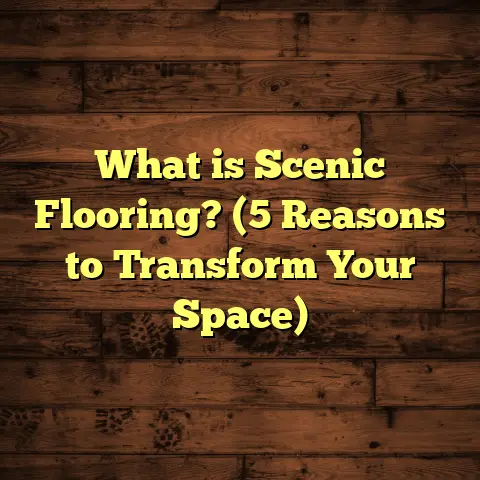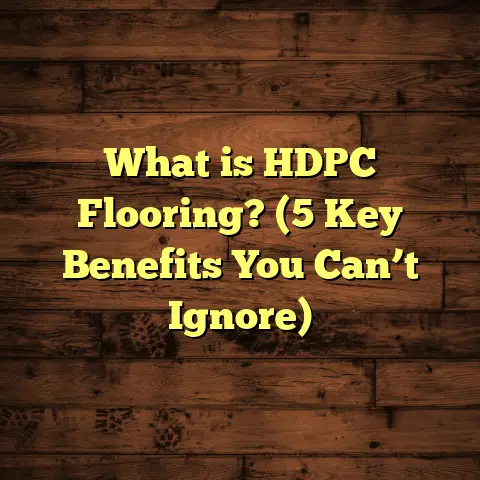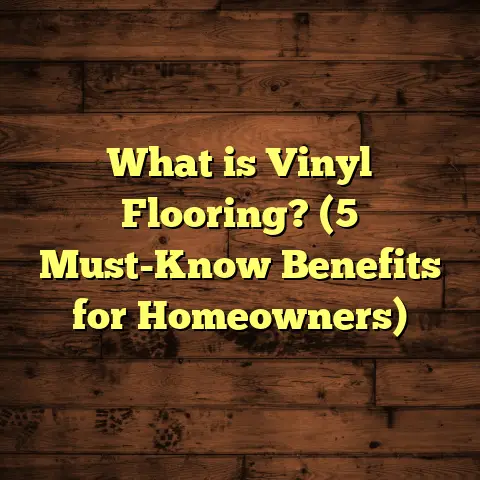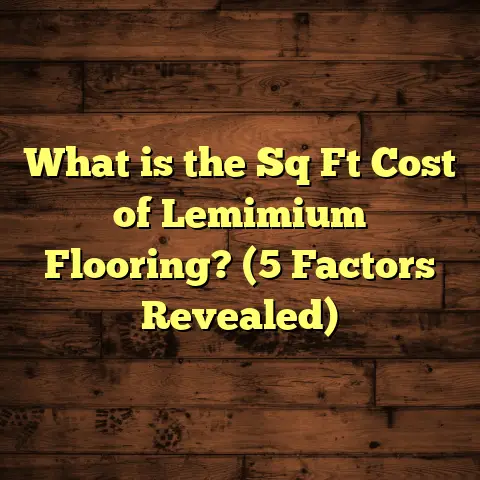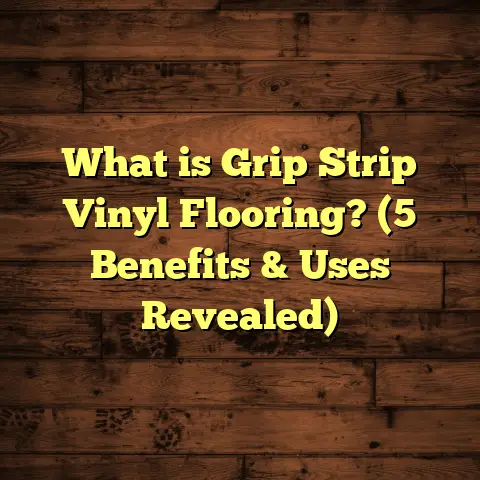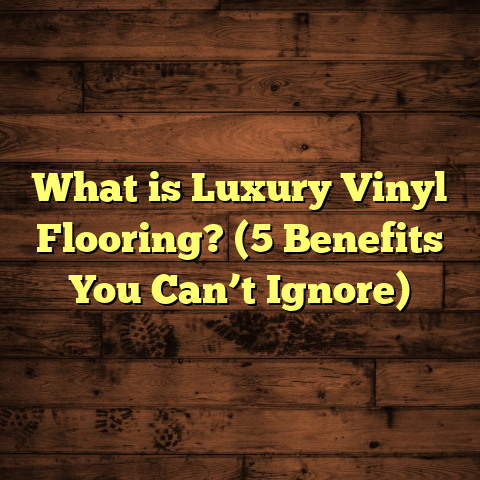What Is Waterproof Flooring? (5 Benefits You Can’t Ignore)
Have you ever spilled a glass of water on your floor and panicked, worrying about damage? I know I have. That’s exactly when waterproof flooring becomes a lifesaver. After years in the flooring business, I’ve seen how choosing the right type of floor can save homeowners from stress and costly repairs. It’s not just about keeping your floors dry—it’s about protecting your investment and making life easier.
Let me take you through everything I’ve learned over time about waterproof flooring, why it’s such a game-changer, and what benefits you absolutely can’t ignore.
What Is Waterproof Flooring?
Waterproof flooring is a type of floor covering designed to resist water penetration completely or to a very high degree. Unlike regular flooring materials which may absorb moisture, warp, or develop mold when exposed to water, waterproof flooring can handle spills, humidity, and even flooding without losing its structural integrity or aesthetic appeal.
You might have heard the term “water-resistant” before. The difference is key—water-resistant means the floor can resist water for a short time but eventually absorbs it if exposed long enough. Waterproof flooring, on the other hand, prevents water from seeping through altogether. This is why it’s such a strong choice for rooms where moisture is common—like bathrooms, kitchens, laundry rooms, and basements.
Technically speaking, waterproof flooring usually includes several protective layers:
- A waterproof core made from materials like PVC or stone plastic composite (SPC) that doesn’t absorb water.
- A sealed surface layer that repels liquids and resists stains.
- Interlocking edges that create a tight barrier between planks or tiles, stopping water from sneaking underneath.
Materials that fall under this category include luxury vinyl planks (LVP), waterproof laminate, ceramic tile with waterproof grout and backing, and special engineered hardwoods treated for moisture resistance.
My First Encounter with Waterproof Flooring
I remember my first big project with waterproof flooring was for a young family renovating their basement. They’d experienced flooding in previous years which ruined their carpet and some wood floors. When I suggested waterproof vinyl planks for their basement and laundry area, they were skeptical at first—worried it wouldn’t look as nice as real wood.
After installation, they were amazed. The floor looked modern and warm but felt solid underfoot. When their washing machine leaked six months later, the floor didn’t budge. No warping, no stains—just easy cleanup. That moment really changed how I viewed waterproof flooring—not just as a practical solution but as a lifestyle upgrade.
5 Benefits You Can’t Ignore
Let’s get into the benefits that make waterproof flooring more than just a buzzword. These aren’t just claims; they’re backed by data and real-world outcomes I’ve seen myself.
1. Protection Against Water Damage
Water damage is one of the most common and costly problems homeowners face with floors. Water causes wood to swell and warp, laminate to peel up, tile grout to weaken, and carpets to grow mold and mildew.
According to a 2023 report by the National Association of Home Builders (NAHB), water-related flooring claims represent over 30% of all flooring repair cases annually in the U.S., costing homeowners an average of $3,500 per incident.
When you install waterproof flooring, you essentially eliminate this risk—or at least reduce it drastically. Because these floors don’t absorb water, spills can be wiped up quickly without damage. Basement flooding or high humidity becomes less of a threat.
Personal Story:
I once had a client whose dog knocked over a water bowl every day for weeks. Before switching to waterproof vinyl planks, this would have soaked into the floor and caused swelling over time. After the upgrade, they just wiped it up daily—no damage at all.
This benefit alone can save thousands of dollars over the lifespan of your floors.
2. Durability and Longevity
Waterproof floors are built tough. Many feature scratch-resistant surfaces that hold up well to heavy foot traffic, pets’ nails, and moving furniture. The core structure of these floors is designed to stay stable even in wet conditions where traditional wood or laminate would buckle.
For example, luxury vinyl planks (LVP) use a rigid core made from materials like SPC (stone plastic composite) which resists dents and moisture simultaneously. This durability means your floors maintain their look longer without fading or cracking.
I installed a waterproof laminate floor in a daycare center three years ago. With dozens of kids running around daily, spilling juice and snacks everywhere, those floors still look nearly new—a testament to their strength.
3. Easy Maintenance
Cleaning your floors shouldn’t be complicated or time-consuming. Waterproof flooring makes maintenance a breeze because liquids don’t soak in or stain the surface.
Most homeowners I work with love that they can mop or wipe floors with standard cleaners without worrying about warping or discoloration. There’s no need for special sealants or treatments like you might require with hardwood.
A quick story: One client with three kids told me she loved how easy it was to keep her waterproof vinyl plank kitchen floor clean after switching from carpet—which trapped dirt and stains constantly.
4. Versatile Design Options
You might think waterproof flooring only comes in boring synthetic looks—but it actually offers tons of design variety. Manufacturers have gotten incredibly good at mimicking natural materials like hardwood, stone, and ceramic tile with realistic textures and finishes.
From matte oak planks that look like reclaimed wood to glossy stone patterns perfect for bathrooms, you can find styles that fit almost any décor preference.
In one recent project, a couple wanted the warmth of hardwood but needed something waterproof for their beach house kitchen. We chose LVP that looked exactly like distressed walnut but handled salty air and spills perfectly.
5. Cost-Effective Over Time
Some people hesitate at the upfront price tag for waterproof flooring options like luxury vinyl plank or waterproof laminate compared to basic laminate or carpet.
But when you factor in durability, lower maintenance costs, and fewer repairs or replacements needed over time, waterproof flooring often ends up saving money in the long run.
A study by Remodeling Magazine found that replacing carpet with luxury vinyl planks in wet areas reduced maintenance and replacement costs by nearly 25% over five years on average.
How I Use FloorTally for Cost Estimates
When planning projects involving waterproof flooring, I rely heavily on FloorTally—an online tool that helps me calculate installation costs based on local material prices and labor rates. It makes budgeting much more straightforward because it incorporates waste factors (which are crucial—you never want to order too little or too much) and gives me visual cost breakdowns.
Using FloorTally has saved me hours of guesswork and back-and-forth with suppliers. It also helps me give clients realistic quotes upfront without surprises later.
Diving Deeper: Types of Waterproof Flooring
Since “waterproof flooring” covers several materials, here’s a breakdown of popular options with pros and cons based on my experience:
Luxury Vinyl Planks (LVP)
- Waterproof level: Very high
- Durability: Excellent; resistant to scratches and dents
- Maintenance: Easy; mop or sweep regularly
- Appearance: Mimics wood or stone closely
- Installation: Click-lock systems or glue-down options
- Cost: Moderate
LVP is my go-to recommendation for kitchens and basements because it balances style with toughness. I installed LVP in an Airbnb rental property where spills were guaranteed daily; it held up perfectly despite heavy use.
Waterproof Laminate
- Waterproof level: High (but some seams may allow water penetration if not installed well)
- Durability: Good; less resistant than LVP but better than standard laminate
- Maintenance: Simple; avoid standing water
- Appearance: Wood-like finish
- Installation: Floating floor with click-lock edges
- Cost: Affordable
Waterproof laminate is great for budget-conscious projects wanting wood aesthetics without hardwood costs. In a recent condo renovation, waterproof laminate performed well in the kitchen despite occasional water spills.
Ceramic Tile
- Waterproof level: Naturally waterproof tiles but grout lines must be sealed well
- Durability: Very high; scratch-resistant but can crack under heavy impact
- Maintenance: Requires grout sealing periodically
- Appearance: Wide variety of colors/patterns
- Installation: Requires professional installation for best results
- Cost: Moderate-high
Tile works wonderfully in bathrooms but can feel cold underfoot unless paired with radiant heating. One bathroom project I did used large-format porcelain tiles with epoxy grout for maximum waterproofing and durability.
Engineered Hardwood (Special Waterproof Varieties)
- Waterproof level: Moderate; some engineered woods are treated for moisture resistance but not fully waterproof
- Durability: Good; better than solid hardwood in moist environments
- Maintenance: Requires care to avoid standing water
- Appearance: Real wood grain finish
- Installation: Nail-down or floating systems
- Cost: High
While not fully waterproof like LVP or tile, certain engineered hardwoods offer better moisture resistance than traditional hardwoods. It’s an option if you want real wood aesthetics but need moderate water protection.
Case Study: Basement Renovation Using Waterproof Flooring
A client called me last year after their basement flooded during heavy rains. They had carpet that was ruined by mold after sitting wet for days.
We recommended installing luxury vinyl plank flooring because:
- It could withstand future flooding without damage.
- It looked warm and inviting—unlike cold concrete.
- It was easy to clean after any future leaks.
We used FloorTally to estimate costs accurately based on local labor rates and material prices. The final budget was within 5% of initial projections—no surprises there!
Six months later, another heavy rainstorm caused minor flooding again. The client texted me saying how relieved they were their new floors didn’t warp or stain at all — just wiped clean easily.
Data That Supports Waterproof Flooring Choice
Looking at market trends and research:
- The global waterproof flooring market size was valued at $14 billion in 2022 with projected annual growth of 7% through 2030 due to rising demand for durable home solutions (Source: MarketWatch).
- Consumer surveys show over 60% of homeowners prioritize water resistance when selecting new floors.
- A 2023 study found homes with waterproof vinyl plank floors had 40% fewer moisture-related complaints compared to homes with hardwood or carpet floors.
These numbers tell me something important: Waterproof flooring isn’t just a fad—it’s becoming a standard expectation for modern living spaces prone to moisture exposure.
Comparing Waterproof Flooring to Other Solutions
Let’s look at how waterproof flooring stacks up against other popular options side-by-side:
| Flooring Type | Water Resistance | Durability | Maintenance | Comfort | Cost |
|---|---|---|---|---|---|
| Hardwood | Low | Moderate | High (needs care) | Warm & natural | High |
| Laminate | Moderate | Moderate | Moderate | Moderate | Moderate |
| Carpet | Very Low | Low | High | Soft & warm | Low |
| Tile | High | Very High | Moderate | Cold & hard | Moderate-High |
| Waterproof Vinyl Plank | Very High | High | Low | Comfortable | Moderate |
Hardwood scores well on comfort and aesthetics but fails water tests unless you’re super careful. Carpet feels cozy but is disaster-prone near moisture sources. Tile wins on water resistance but isn’t always cozy for living spaces.
Waterproof vinyl plank strikes a balance: it looks good, feels nice underfoot, handles water well, and is relatively affordable.
What About Installation?
The lifespan and performance of any floor depend heavily on installation quality. Waterproof floors require attention to detail:
- Subfloor must be clean, dry, and level.
- Planks/tiles must be properly locked or sealed.
- Expansion gaps should be left where necessary.
- Professional installation reduces error risks.
I always recommend hiring skilled installers familiar with waterproof products because improper fitting can let water seep through joints — defeating the entire purpose.
My Tips for Choosing Waterproof Flooring
If you’re thinking about upgrading your floors with waterproof materials, here are some things I consider before every job:
- Room Type: Kitchens, bathrooms, basements benefit most from waterproof options.
- Foot Traffic: Choose more durable types like SPC-based LVP for high-use rooms.
- Budget: Use tools like FloorTally early on to gauge costs accurately.
- Style Preferences: Look for products offering the look you want without compromising functionality.
- Warranty: Check manufacturer guarantees related to water damage.
- Maintenance Routine: Pick something easy to clean if you want low upkeep.
- Environmental Conditions: Consider humidity levels in your location.
One homeowner near the coast told me how salty air ruined their hardwood porch floor repeatedly before switching to waterproof vinyl — now it looks great even after years by the ocean.
Final Thoughts: Why I Recommend Waterproof Flooring
Over my career installing hundreds of floors in homes and commercial spaces alike, I’ve learned one truth: moisture is one of the biggest enemies of flooring longevity.
Waterproof flooring removes that enemy almost entirely — giving you peace of mind without sacrificing style or comfort. It handles everyday accidents easily while lasting far longer than many traditional options when exposed to water regularly.
Whether you’re renovating a kitchen prone to spills or finishing a basement where flooding risks exist, waterproof floors are smart investments that pay off in durability, ease of care, and cost savings down the line.
If you want my honest advice based on years on the job: seriously consider waterproof flooring as your next step toward durable, beautiful floors that stand up to life’s little messes—and big ones too.
What kinds of spaces in your home would benefit most from this? Let’s chat if you want help sorting through options or estimating costs—I’m happy to share what I know!
